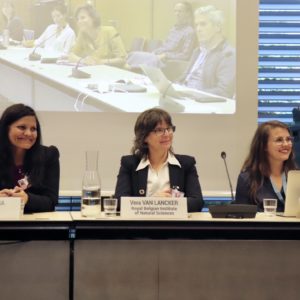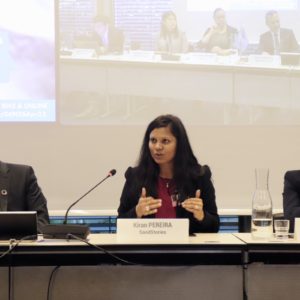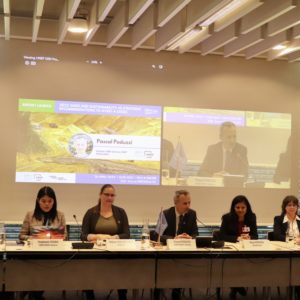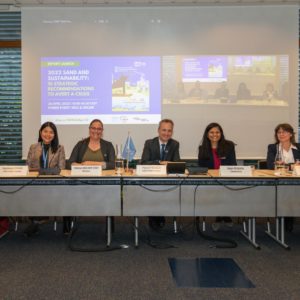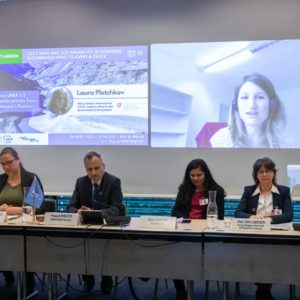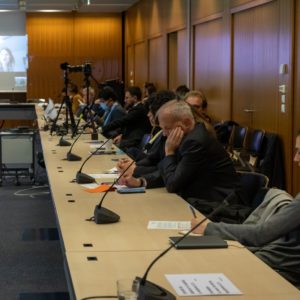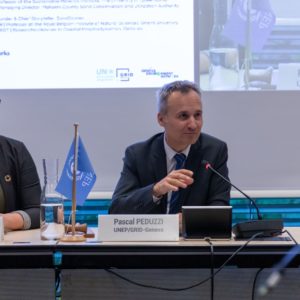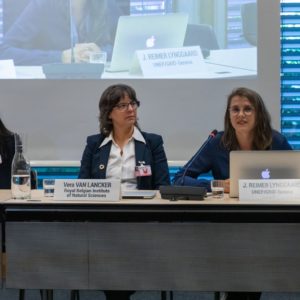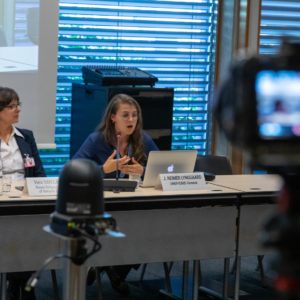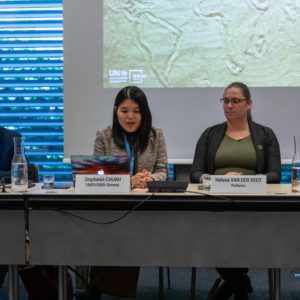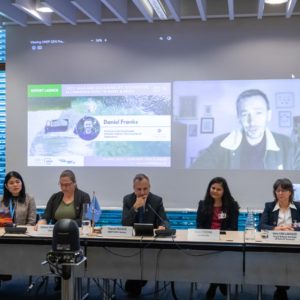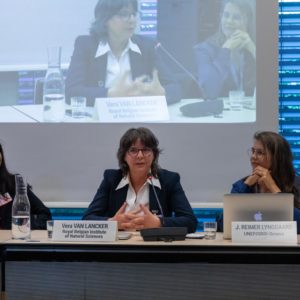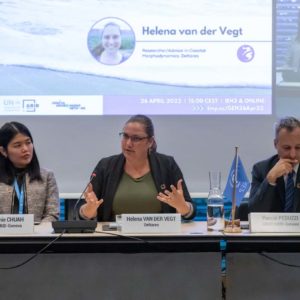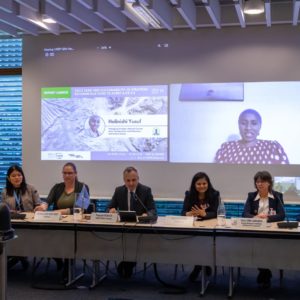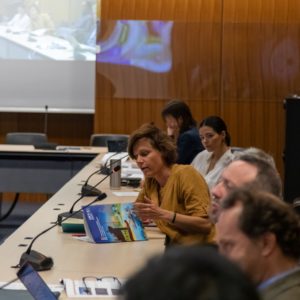Événement Conférence
Sand and Sustainability: 10 Strategic Recommendations to Avert a Crisis | Report Launch
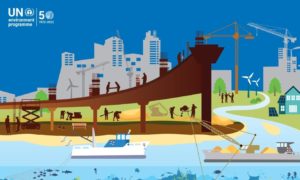
26 Apr 2022
15:00–16:30
Lieu: International Environment House II & Online | Webex
Organisation: UNEP Global Resource Information Database Geneva, Geneva Environment Network
This hybrid event launched a new publication “Sand and Sustainability: 10 Strategic Recommendations to Avert a Crisis”, and was organized by UNEP/GRID-Geneva and the Geneva Environment Network.

About the Session
Sand plays a strategic role in delivering ecosystem services, vital infrastructure for economic development, providing livelihoods within communities and maintaining biodiversity. It is linked to all 17 Sustainable Development Goals (SDGs) either directly or indirectly. Despite the strategic importance of sand, its extraction, sourcing, use, and management remain largely ungoverned in many regions of the world, leading to numerous environmental and social consequences that have been largely overlooked.
This event launched the report “Sand and Sustainability : 10 strategic recommendations to avert a crisis” consolidating the expertise in sand and sustainability from different sectors. The report was prepared by a team of 22 authors led by Pascal Peduzzi, director of the United Nations Environment Programme/GRID-Geneva, in response to the UN Environment Assembly resolutions UNEP/EA.4/Res.19 on mineral resource governance and UNEP/EA.4/Res.5 on sustainable infrastructure. The report supports also a new resolution on the Environmental aspects of minerals and metals management requesting to raise our environmental standards on how to manage these resources adopted in March 2022.
It also benefited from the input of an expert roundtable convened on 12 October 2021 in Geneva, with the support of the Geneva Environment Network.
Leading experts taking part in this event brought attention to the impacts from the current state of extraction, use and (mis)management, putting forward recommendations for actions to set the global sand agenda in addressing environmental sustainability needs alongside justice, equity, technical, economic, and political considerations.
Speakers

Laura PLATCHKOV
Policy Advisor, International Affairs, Federal Office for the Environment, Switzerland

Josefine REIMER LYNGGAARD
Sustainability & Governance Lead, UNEP/GRID-Geneva

Stephanie CHUAH
Project Manager, UNEP/GRID-Geneva

Daniel FRANKS
Professor at the Sustainable Minerals Institute, The University of Queensland

Halinishi YUSUF
Managing Director, Makueni County Sand Conservation and Utilization Authority in Kenya

Kiran PEREIRA
Founder & Chief Storyteller, SandStories

Vera VAN LANCKER
Professor at the Royal Belgian Institute of Natural Sciences; Ghent University

Helena VAN DER VEGT
Researcher/Advisor in Coastal Morphodynamics, Deltares
Video
In addition to the live WebEx and Facebook transmissions, the video of the event is available on this webpage.
Summary
Welcome and Introduction
Pascal Peduzzi | Director, GRID-Geneva, UNEP
Our society depends on sand. Altogether, this material is being produced very slowly through an erosion process happening in geological time which takes hundreds of thousands of years, and we are using sand in a very fast way at 50 billion tons of sand and gravel per year, which represents a wall of 27 meters high and wide all around planet every single year.
You cannot withdraw 50 billion tons of sand out of the environment without generating an impact on the environment and society.
We must differentiate two cases: taking from a static environment vs from a dynamic environment.
- In static environment, sand and gravels are not directly interacting with the ecosystem.
- An example can be seen in quarries where you dig a hole. This has an impact on the environment in terms of landscape, but after 50 or 60 years of operation, you can use that hole to get rid of some inert material and then recover it back to agricultural land or forest. You can also smash and crunch rocks from mountains and make sand and gravel. This also has a visual impact, but not as bad as when you take it from a dynamic environment.
- Dynamic environments can be the beach, rivers or the marine environment.
- For instance, the beach is a very dynamic area of interface between the sea and the land, protecting against coastal erosion, infiltration of salty water into coastal aquifers. It is the home of turtles, crabs, birds, and it offers the possibility of having touristic development. If you remove the beach, you lose all of that.
- In rivers, if you take the sand, you change the river flows: they can go faster or slower, having impacts on floods or droughts. It can lower the aquifer, it can have impacts on the river bench that can get eroded, it changes the turbidity of the water with impact on the fishes therefore on the livelihoods of some people.
- For the marine environment, if you take the sand from the bottom of the ocean, you are sterilizing the area by crunching all the microorganisms, therefore changing the biodiversity and the fisheries. It also causes a plume behind the boats that reject the small particles that are not of commercial value, thus changing water visibility.
To address these impacts, a first publication was issued in 2014. To look at the solutions to the problems identified in this publication, we gathered in this room. This room [in the International Environment House] is quite important for sand. In October 2018, this is where we held the first expert round table on sand. In March 2019, we had the launch of the 2019 report, done by the Executive Director of UNEP. That report was circulated in the United Nations Environmental Assembly, and led to a resolution. In October 2021, we held here the second expert round table, and now we are launching the report from this room. This is where everything started, and maybe one day, we get to see convention on the use of sand.
Our first report had impact on international policy.
- In 2019, we got this first resolution on mineral resource governance that was adopted by all member states at the United Nations Environment Assembly.
- In 2020, there was a motion for the urgent global management of marine and coastal sand resources by the member states at the IUCN World Conservation Congress.
- At the 5th UN Environmental Assembly in Nairobi in March, a new resolution was adopted, on metal and minerals that also requests governments and the Executive Director of UNEP to continue the research on best practices, standards and minimize the impact that is associated with the extraction of sand.
Today, we are launching the second report “Sand and Sustainability: 10 Strategic Recommendations to Avert a Crisis“. We believe it is still early, and if we start acting now, we can avoid getting into a crisis and for once, try to prevent it, instead of reacting to it.
We have 10 recommendations, organized in the following manner:
- Recommendations 1, 2 and 3: Setting the overarching agenda
- Recommendations 4 and 5: Setting the right institutional and legal structure
- Recommendations 6, 7, 8, 9 and 10: How we are going to implement these more technical recommendations?
Every recommendation addresses six different stakeholders: governments, the civil society, international entities, extractive industry and sand producers, end-users and financial institutions.
With regards to the report’s numbers, this report has: 10 recommendations, 43 actions, 22 lead authors and 25 reviewers from various regions, 3 international mandates, 15 SDGs, 17 case studies, many experts interviewed, 6 target audiences and more than 230 references.
But the big number is still there: 50 billion tons of sand.
Introducing the New UNEA 5.2 Resolution & Swiss Government’s Position
Laura Platchkov | Policy Advisor, International Affairs, Federal Office for the Environment, Switzerland
This report brings much knowledge on the topic of sand and can inspire the forthcoming discussions on what concrete actions government, industries, end-users and other stakeholders can take to manage sand more sustainably. Many of us do not realize the importance of sand in our daily lives. Every day we consume 18 kilos, and its extraction has increased a lot over the last decades, by a factor of 5 in the last 50 years. If this trend of demand continues to grow, more massive infrastructure needs in the coming years.
It is striking to see that sand and gravel account for the largest volume of solid material extracted globally, but still is perceived in many regards as in significant and unlimited. This report demonstrates that this is problematic for many reasons, mainly for of the importance of sand but because it also has major environmental impacts on rivers, coastal and marine ecosystems.
This report shows alerts as well about the fact that the long-term availability of sand should not be taken for granted. However, despite this difficult context, it is encouraging to see the strong political momentum and the worldwide awareness around the necessity to tackle these challenges.
UNEP/GRID-Geneva has made instrumental work since its first report released in 2014, and it is really good to see that since 2019, no less than four resolutions were adopted by the UN Environmental Assembly, which call for a more sustainable management of sand or mineral process more generally, and also for better use of sand in infrastructure.
- The resolution also recognizes the important work of UNEP/GRID-Geneva, in particular the resolution on environmental aspects of minerals management, adopted early March, specifically requests UNEP/GRID-Geneva to strengthen this policy knowledge on sand to really support global policies and action for the environmentally sound management of sand.
- The resolution also requests UNEP to conduct an intergovernmental process of consultations where member states will be requested to develop proposals to enhance the environmental sustainability of minerals. This proposal will be considered at the next UNEA6 in 2024.
This report with the 10 recommendations and the list of possible actions identified can inform this intergovernmental process and the elaboration of these proposals, but also, can inform the wider stakeholder exchanges.
Introducing Report Recommendations
Josefine Reimer Lynggaard | Sustainability and Governance Lead, UNEP/GRID-Geneva
The ten recommendations aim to be cross-sectoral and cross-border in the solutions that they put forward.
Recommendation 1. recognizing sand’s strategic value by formalizing and evaluating the role that it provides for human life, ecosystem services, sustaining biodiversity and many other functions. This requires anticipating to the demand that will come with the growing sand demand by the population growth, by the migration from rural to urban areas, but also catching up with development. This is not just specific to one area but an issue that we will see emerging across the world
Recommendation 2. It is necessary to set an overarching agenda that includes place-based perspectives for just sand transitions, ensuring the voice of all the impacted by policy actions are included in the dialogues and negotiations around the solutions and their implementation. This requires including their voices in any discussions, and companying workers’ rights in a transition and ensuring that the governance of any solution is done at the same scale as the issue.
Recommendation 3. Enabling a paradigm shift, because these types of solutions require systemic shifts in how we operate our economies and organizational structures and that will take time. Many solutions are already out there being tested, which will require addressing barriers that can be addressed through promoting public-private knowledge networks, aligning, fiscal policies, encouraging capacity building within some of the key sectors that we are discussing, including construction mining architecture, and these hints to the many stakeholders that we need to bring to this table for these solutions to be implemented in the long term.
Recommendation 4. This shift will require a system that works to support these changes. Adopting strategic and integrated policy and legal frameworks that facilitates these goes in hand in hand and how we govern this resource. One option that we are putting forward in this report is aligning these policy and legal frameworks that work on the ground. The situation is very different, whether you are discussing Asia, Africa, South America, or the European continent. Any solution needs to be fitted to the local context, development imperatives and resource ability that goes with it. An approach like policy integration could work hand in hand with this. Policy problems need to be understood, common visions need to be set and working along with stakeholders across the sand value chain, ensuring that policy actions are compatible, but that they also align between different stakeholders.
Recommendation 5. Moving towards this type of just sustainable sourcing extraction, but also use and transport of sand, requires establishing ownership, but also access to these resources through mineral rights and consenting firm that regulates how this resource is being extracted, sourced, and sold. That goes here in hand with creating a legal framework that works for a locally accepted commercial mechanism for cost recovery.
Stephanie Chuah| Project Manager, UNEP/GRID-Geneva
Recommendations 6-10 regard the implementation level and are considered instruments needed to manage sand as a resource.
Recommendation 6. Map, monitor and report sand resources for transparent, science-based and data-driven decision-making. These entail investing in strategic resource-mapping, accounting, and monitoring along the production-consumption chain to include extraction, use, transport and end of life, to be able to ensure long term supply and to have more research to mitigate environmental impacts.
Recommendation 7. Establishing best practices, national standards, and a coherent international network regards extraction of primary resources and technical standards for materials and building infrastructure. Standards and best practices on how to minimize impact when we extract exist, however, there is a need to share and test them at the multilateral level and for them to be updated when needed. This makes an international framework for these standards and guidelines necessary.
Recommendation 8. Promote resource efficiency and circularity, which for the sand supply chain means reducing the demand for sand and replacing the use of naturally occurring sand, and to reuse sand-containing products, and finally recycling when reusing is not possible. To do this, it is necessary to promote policies and provide cost incentives to mainstream tests and support these alternatives.
Recommendation 9. Sourcing responsibly calls for the adoption of a responsible sourcing framework and to implement the principle of supply-chain accountability. This means engaging with the multiple players in infrastructure projects from funders to extractors, and to ensure that accountability is managed at the highest level possible.
Recommendation 10. Restoring ecosystems and compensate remaining losses means minimizing the impact of sand mining projects on biodiversity and ecosystem services. For these, we must adopt nature-based solutions and compensation mechanisms to restore degraded ecosystems.
Panel Discussion
Daniel Franks | Professor at the Sustainable Minerals Institute, The University of Queensland
How can we ensure that people working in informal settings still have livelihoods and are not negatively affected when sand mining is shifted by regulations?
Millions of people mine sand in thousands of places. If we are going to make that shift away from the unsustainable settings, it is going to imply a huge transformation that could affect a really large number of people.
Sand is predominantly locally-mined and a significant proportion of sand mining is by artisanal small scale models. Mining is a livelihood strategy in circumstances of poverty. In the report, we described what a just transition might look like, and we highlight the importance of involving all interested people, and incentivize governance and decision making, especially the workforce that, could be impacted by reforms.
This is important because being informal is not the same as being unsustainable, and there must be accessible pathways for the formalization of sand mining accompanied by well-designed environmental and social obligations. The only way to make a successful environmental transition is to create a successful social transition through best practices, or through alternate livelihoods and opportunities.
The public perception of the issue often always stops at its surface and describes this solely as an issue of illegal mining, calling people involved in it “sand mafias”. Why is this inappropriate and why is it important to shift this narrative crackdown on illegal extractions?
Having spent a lot of time with sand miners in many countries, it is easy to realize that the circumstances in which mining takes place are complex. Describing sand miners as criminals or “sand mafias” is inconducive to achieving the inclusivity needed to address the problem. Sand miners face huge barriers to obtaining legal licenses.
In some countries, sand is excluded from the formal definition of minerals, making it impossible to mine legally. The loose use of the term “sand mafia” is incorrect because it implies that informal sand miners are in positions of power, which is not the situation in many places. There definitely exist sand mining actors that will resist change or that extract without minding environmental or social consequences, or who have used power, corruption, or even violence to entrench the status quo. However, generalizing examples where sand mining is linked with criminal activities to be the global situation is not very productive.
We need to mobilize large numbers of people to practice change, many of whom are coming from a situation of poverty and that will be possible only if people are brought along in the process and if that change results in improvements in livelihoods.
Vera Van Lancker | Professor at the Royal Belgian Institute of Natural Sciences; Ghent University
Are we running out of sand? What can be done to monitor and report on sand extraction?
From a geological perspective, sand is abundant. However, this is different from a quality and quantity perspective, and we do not know the answer. There are only a few places where sand reserves have been mapped leaving plenty of areas globally unmapped. Models to count the amount of sand and its qualities are available only in few places, despite this being fundamental information from an industrial perspective.
More stringent environmental regulations on human activities, both on land and at sea, and the growing need for the protection of cultural heritage, are making sand resources increasingly less accessible. The actual sand reserves that can be exploited both in terms of quality and quantity, are indeed decreasing in some regions. This shortage is particularly relevant in high-quality sands.
We must speed up the process of mapping, starting from areas where no data exist. For this, it is necessary to join up and build structural collaborations, leveraging geological surveys, knowledge-sharing, capacity-building and training. There is a long way to go, but through partnerships a lot can be achieved.
What has been done on marine sand extraction and should it be banned?
Offshore developments in marine sites are increasing and much debate is ongoing on how to do it through blue growth initiatives. These need sand, but the sand demand is seldom spoken out, and we are not aware of the amount of sand needed.
This requires regulation but to achieve actual results, monitoring and reporting of sand are also necessary. By monitoring different extraction regimes, we can learn and share best practices. There is a need for more cooperation between experts and practitioners in the field with industries on how to improve and minimize the impact on the environment. Investing in a standard on best practices is key to assess how to set up decisions, support systems and safeguard the environment while having a sustainable supply of sand.
Helena Van Der Vegt | Researcher/Advisor in Coastal Morphodynamics, Deltares
How can we extract send and minimize the impact of sand extraction? If such extractions cause impacts, is there a need for compensation?
Recommendation 10 contains a framework for helping decision-makers to balance the impacts on biodiversity and ecosystem services with the need for the development of societies and economies. It consists of four steps: avoid, minimize, restore and compensate.
- When a sand extraction process starts, we first assess whether extracting the sand can be avoided.
- The amount that cannot be avoided is minimized and left in that in place.
- For what it is extracted we restore the ecosystem services and the biodiversity in the areas extractions are made.
- Where this is not possible, we compensate, perhaps bringing biodiversity or the same ecosystem services back to a different location.
If we take all of these four steps together, we do not only compensate and restore the ecosystem, but in many cases, this even improves biodiversity. This has been the case in a number of onshore and on land sand and extraction projects in the past.
The report is also targeting governments and other stakeholders, what can they do?
In addition to the policy points, there is a responsibility for knowledge development and knowledge sharing when it comes to sand extraction. For example, the Dutch government through the National Science Agenda has recently funded a large project, which will look at sustainable sand extraction from the North Sea. Still, these kinds of large projects are not necessarily practical everywhere in the world.
It is necessary that people engaging in such projects report, share and discuss challenges they encounter with experts because we are interested in knowing what local challenges are. Only by collaborating, working together and speaking to each other we can start to solve these problems. There are many nature-based solutions we can implement, but we need to get the conversation going.
Is this something that the supply chain can do?
This relates to responsible sourcing. We usually think limiting the social and environmental impact at the source is the most important thing, but there is also responsible production. Products made of sand must be designed to be sustainable at all stages of the lifecycle and end of life and this requires to engage all the involved stakeholders in responsible sourcing of the supply chain.
Companies are encouraged to join the UN Global Compact, supporting them to manage businesses sustainably. Planning is another important aspect of it and where government guidance is needed. We must plan what sand will be needed and when because if we start extracting sand at the last minute start, it is much more difficult to do it in a sustainable way. If we know what we will have to deal with, it is much easier to do this in a sustainable way.
Halinishi Yusuf| Managing Director, Makueni County Sand Conservation and Utilization Authority in Kenya
Sand harvesting in Makueni County was done in dry river beds, as most rivers are ephemerals, flowing for limited periods during the year. These rivers are used for commercial uses as ferry trucks cross them. Excessive sand harvesting led to huge environmental degradation, lowering water levels in rivers. This phenomenon was associated also with many social issues such as violent conflict, school dropout rates due to the profitability of mining, and early pregnancies in young girls. Nevertheless, since the introduction of regulations in 2015, these issues are under control.
In Makueni County, we started by recognizing that many years of unregulated and excessive sand harvesting from the river beds was leading to more problems than goods. We went for regulation of sand harvesting because the government recognized that sand harvesting will continue to be practiced as long as there are no alternatives.
- Therefore, the government decided to use the regulations on how to harvest and where as entry points, keeping in mind environmental protection. The County banned sand harvesting for exports outside the county, and in 2015 it came up with the legislation that created. The Sand Authority role consists in supervising sand within the County, promoting sustainable conservation, mitigating and providing for sustainable utilization and most importantly, ensuring equitable benefits-sharing of revenues generated from the sale of sand.
- Since 2015 Makueni County has maintained a ban on exports of sand, and this has reduced the pressure on sand resources of the rivers as sand is being consumed only within the County. Social vices such as the infiltration young children into the mining sector has been dealt with and since 2016 there has not been a single violent conflict due to access and control of sand. The success of the body regulating sand harvesting is effective also thanks to the collaboration with the community.
The regulation has also led to collection of revenues that are reshared within the community through conservation efforts. Sand dams have been built and are effectively contributing to rivers restoration. We see that success is given by a combination of regulation to decrease sand use and increase efforts to rejuvenate the river ecosystem. This has incredible livelihoods improvement effects as easier and prolongated access to water for the community.
Hopefully, the model set up within Makueni County can be of inspiration to others and attract more research and support. The regulations led to a successful journey, but it is not yet completely under control. Being the only County regulating sand harvesting, monitoring and enforcing the regulation is challenging as rivers are transboundary limits.
Attempts to raise awareness through public campaigns only have meager results as sand issues are still not very well understood by a lot of people at all levels. This might be why governments and stakeholders may not have recognized the need to start this conversation and shift the paradigm on how we deal with sand issues. We must educate the masses on sand sustainability and on the effects of unregulated sand harvesting, and invest in research to find solutions.
Successes in controlling sand harvesting need to entrench governance. Sand governance needs a regional approach and a national framework to coordinate sub-national governments that would like to continue exploiting their resources sustainably. Working in isolation is impossible. Results can only be achieved if we all work together.
As the Report highlights, a one-solution-fits-all approach is not possible. Research is also necessary to fill the gap on sustainable standards and quantities of sand mining. Having scientific backing to campaigns will surely help to push a momentum on setting the agenda for sand.
Kiran Pereira| Founder & Chief Storyteller, SandStories
What are the various options we have to reduce and extraction? Can we completely rethink our relationship to sand?
Definitely. As one of the people interviewed for my book Sand Stories said, “the Stone Age did not end because there were no stones”. This inspired me to think about what if we decide to build infrastructure with a different array of materials used with vernacular ones such as bamboo, timber, hemp, and waste material. This is not solely already possible; it is a win-win solution for development and the environment. This is currently not done because many systemic barriers and embedded biases associated with construction materials are in place.
Misaligned policies can kind of lock in the status quo, and insufficient insurance for regenerative, renewable materials prevents people from trusting those kinds of solutions. For instance, policies sometimes incentivize demolition as it is cheaper to pull down and rebuild than it is to maintain and retrofit. Policy shifts from these are urgently required as they can help the climate, biodiversity and pollution.
In terms of embedded biases within systems, we sometimes see the remaining of colonial powers impositions for building codes on many places. This led in some cases to vernacular architecture to be classed as weak and impermanent, whereas concrete and steel architecture got classified as strong and powerful.
Can you share some examples of a projects that supports regenerative architecture?
The LILAC project (Low Impact, Living Affordable Community) in Leeds UK, builds housing out of straw bale and timber for families. Studies have shown that if every home in the UK was built in that way, there would be a 42% reduction in global greenhouse gas emissions. Immense amount of water could be saved.
Around the world, countries are trying to upcycle materials that are currently part of waste streams and repurpose them to build construction material. Circularity and sustainability begins at the design stage. When designing a building and choosing the materials for doing it, we must ask what will happen to the building throughout time and where its construction materials will end up. We must start developing building material passports and reversible building designs and the various examples out there show that it is really possible.
Pascal Peduzzi
The information contained in the Report and in SandStories might be new to some, but have been known for a long time. These are the type of changes needed to achieve sustainable development. The conception that the earth is infinite and the resources are abundant is still radiated, but this is far from being the case as demand for natural resources increases exponentially. As global population doubled, GDP only multiplied by 21; and yet individuals are equitably using increasingly excessive amounts of resources. We cannot continue like this and we need to understand that sustainable development is about making use of what we have at our disposal without compromising the future of the next generations.
The solution to the sand crisis is part of solving the triple planetary crisis. Tackling climate change is not about adjusting: we must cut emissions by at least 50% in less than eight years. This currently looks unbelievable as we are not able to decrease greenhouse gas emissions, but are still on the path of decreasing the increase. There is a long way to go, but for sand, it is not too late if we act now.
This requires thinking differently. For instance, looking at mobility, we need to shift from the idea that increased mobility is solved with cars and roads, but rather with public transportations. Trains and subways, compared to individual-use cars can fit more people at the same time and can be reused for longer periods. Fixing the mobility issue with public transportation can have spillover effects on greenhouse gas emissions, sound pollution and generating materials by digging up tunnels.
It is important to link these shifts with the idea that these are not lowering people’s quality of life, contrarily they represent opportunities to move faster, avoid being stuck in traffic, and diminish air pollution. This paradigm for sustainable development is not only useful for sand and gravel, but all sectors of human lives. The word sustainable means to keep on going and unstainable growth will lead us to actually stop development. As more people will inhabit the planet in the future, development is still necessary, but only if it is equitable and sustainable that it will be useful to the continuation of human existence.
Q&A
Q: Are there natural alternatives available to substitute sand and are these enough to meet the large demands?
Pascal Peduzzi: Finding another material that can replace the 50 billion tons of sand is challenging, but the Report presented several options.
- A first option is to recycle the material from the buildings that are knocked down. Various countries are already incentivizing it either by taxing landfill or subsidizing recycling so. This also entailed changing the way in which buildings are smashed as “gently crunching” rather than exploding it allows to save up to 100% of this material and recycle it.
- Another option looks at the materials generated by the mining industry as it is the sector that generates the biggest volume materials. Through the projects conducts with Professor Daniel Franks, our teams explored iron extracting sites in Brazil, and realized that the focus on recovering only ore, in that case iron, led them to discard all the rest as leftovers and big tailings. These tailings eventually are not mining waste. After careful chemicals and physical analyses, these resulted not to be heavily polluted material but extremely clean material. Such material could could be refined to 99.5% to 99.7% of silica to be used directly for making glass.
This recycling and finding solutions in materials that are already in place is the way we should go as it allows us extracting new material from the environment and depleting it. After looking at the sand demand worldwide as well as the potential offer for those mining sites, many options to use what we call “ore sand” were identified. This option seems to be the most promising, but as already mentioned, shifting to sustainable building materials like timber, bamboo and more can help to get out of the sand crisis.
Q: Are there other alternatives, perhaps among more traditional materials, that can compete with concrete on price?
Kiran Pereira: Concrete in many cases can be cheap because the costs are externalized onto societies and the environment. As the report mentions, once costs are internalized, a very different picture emerge.
There are many materials that can compete but most of the times these are not used as practitioners face systemic barriers in getting insurances for building projects. In the UK, 50,000 buildings a year are lost to demolition because it is cheaper to just demolish a building. You pay a 5% value added tax on demolition and rebuilding a new build, whereas if you want to maintain the building you must pay 20%. In a context of climate emergency, this is misaligned policy that needs to be addressed urgently.
Q: Are social demands related to sand uses changing? How does the report envisage support for these shifting demands?
For practitioners that have been working on topics for a long time is easy to observe that social demands are changing. As we witnessed a dramatic change in the relationship of people to plastics in the past five years but also in the building world this year’s Pritzker Architecture Price was awarded to an African architect using wood alternatives.
Pascal Peduzzi: People are very sensitive to changes in supply, and the more essential something is to their lives, the more vocal they will be about abrupt changes. The social effects of environmental phenomena are various and sometimes unexpected.
One example occurred in Canton Vaud (CH), where young people demonstrated in the Colline du Mormont to prevent a company to extract gravel and sand from the area and destroy the biodiversity. People are attentive and susceptible to unsustainable uses of natural resources and that addressing environmental issues must be done considering its societal impacts. Sand appears to have an emotional component for people. They are surprised about the sand crisis and really concerned about how it is destroying rivers, coastlines, and marine ecosystems. The more people get to know about it, the stronger they will react to it.
Q: What are the next steps after the publication of this report?
This report compiled an invaluable amount of scientific information to be used to raise awareness. It aims at changing how people perceive sand and convening the message that development is based on this material, thus we need to have a sound strategy to use this resource. Once people recognize the value of sand, we hope their behavior toward it will be wiser.
We aim to create a global sand observatory not as a centralized center but rather as a network. Indeed, the lead authors of this Report are already showing eagerness to continue this collaboration, to keep the energy flowing and keep finding solutions to this issue. Without such efforts, the sand crisis, like climate change and biodiversity loss will not be solved, it would rather haunt us. It is essential to seize the moment to start acting now before these situations worsen.
We wish this report will produce a policy shift, changing laws and regulations to allow the entire extraction industry supply-chain extracts less and in a better way. Monitoring is importance to achieve this. It is absurd that the most extracted material in the world is untracked. We need a clear indication of how much sand is there, who is taking it and for what purposes. We must also identify best practices, standards, and alternatives. Having a network center to do this will surely ease up the process of collecting and sharing this vital information.
Q: Are there sustainable ways to use dredging spoil? Should marine sand be reserved for beach nourishment, especially in small island nations?
Vera Van Lancker: The beneficial use of dredging material has been ongoing for quite some time already. It requires to be looked at case by case as it all depends on the environmental conditions, on the geological nature, and on how and what it is dumped. Maintenance of dredging materials and their potential disposal can be expected in areas where there is natural outwash of sand materials. What remains at the bottom, usually moderate quality sand but homogeneous enough to be used for some construction purposes, and surely for nourishment.
On the other hand, if what is dumped is a combination of maintenance dredging and capital dredging, in many cases digging up brings on the surface also play and hard material. This represents a good mixture to be dumped, leading to heterogeneous dredging spoils. In the future we must think about change dumping strategies and how to foresee in the design phase how materials can be reused and dumped.
Q: Is there a way to extract sand from the marine environment in a sustainable way?
Vera Van Lancker: This must be looked at case by case, depending on environmental condition and geology. One must first ask if the extraction is occurring in a sediment-rich or -poor environment. For instance, on the Belgium shore, extractions have been ongoing for forty years on the sand banks, typically a more dynamic environment. Species living on those banks are more resilient to stress as the natural stress is already higher and.
On the other hand, the fishing activities would typically occur on the turfs in between the sand banks. As long as extraction happens on top of the sand banks fishing can go on until the geology changes. This is the issue present in relatively sand-poor areas, as once you get on to geological layer it stops and he the quality is not the same anymore. Therefore, that sand might represent an issue for construction purposes already.
There is indeed a way of carefully monitoring what and where is extracted and think about establishing thresholds of extraction for doing it in a secure and safe way.
Q: Considering sea level rise, should marine sand be reserved for beach nourishment, especially in small island nations?
Vera Van Lancker: Definitely. From a biodiversity perspective, the beach nourishment material should be as similar as possible to the original beach environment so ideally, you having the same grain sizes or settlement types that would occur naturally. On the other hand, it is important to think about volume: nourishing the beach alone is different from shore nourishment or nourishing the coastal fundament. The volumes of sand one might need must be assess prior construction as without it, maintenance will inevitably lead to losses.
The offshore environment is a quite challenging one, but with a sound strategy and beneficial use of dredge material can you also look it can be fed into.
Solutions should be also found in collaboration with industries. A lot of sand being dredged for harbor construction for other works can be partly be used for beach nourishment in some cases or maintenance works.
Helena Van Der Vegt: Sand preservation and use for beach nourishment is something that needs to be resolved internally by countries as each has different. An upcoming report by Pianc on the beneficial use of settlements and particularly dredging settlement is aiming to address this topic more in depth.
Q: Clarification on ore sand.
Daniel Franks: There’s been many efforts to try and repurpose tailings with mixed results, as it has some minerals and elements unsuitable in the natural environment or for construction. We are discussing adding mineral processing circuits to extract sand as a by-product when extracting metal product.
Q: What conditions lead to informal sand mining?
Daniel Franks: The informal mining sector is hugely neglected. There are three main reasons why it persists.
- Local demand for an easily accessible resource.
- Poverty, where people are looking for livelihood, but have no access to follow formal processes.
- Huge regulatory barriers, where process is unavailable for artisanal small-scale miners to follow.
In many of the countries I’ve worked with on sand mining reform, regulatory acts on mining have been set up by colonial governments. Many of them were looking to regulate the minerals needed for the export to the industrial world. Many of these acts do not cover the local minerals and materials needed for local development. When they do exist, there are too many barriers for ASM workers, from getting permission to scientific studies.
Conclusion
Pascal Peduzzi
The challenges we are facing now are slow-onset problems, such as climate change, biodiversity loss, and pollution. Now, we also face the demise of natural resources such as sand and gravel. These are challenges taking place gradually and systematically. These are looming hazards that come gently but surely, but we are fully-equipped to address these.
We need to change. We cannot wait too long to avert this crisis. These 10 recommendations need to be seriously. If we apply them now, we can get out of this crisis. If we cannot, we need to see how we can mitigate these impacts and live in a poor geological situation with less resources
Documents
- Sand and Sustainability: 10 Strategic Recommendations to Avert a Crisis | UNEP/GRID-Geneva | 26 April 2022
- Slides presented during the event
Gallery
Links
- UN Press Conference of 26 April 2022
- UN environment: world needs to ditch sand addiction | Michelle Langrand | Geneva Solutions | 26 April 2022
- Sand and Sustainability | Finding new solutions for environmental governance of global sand resources | GRID-Geneva & Geneva Environment Network | 7 May 2019 [You may find the report here.]
- GRID-Geneva




